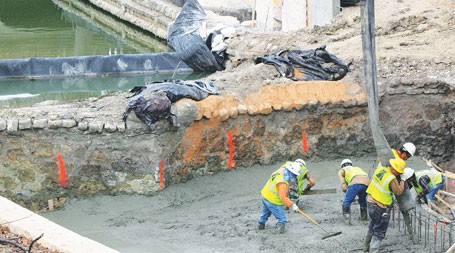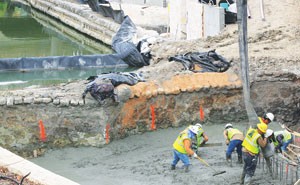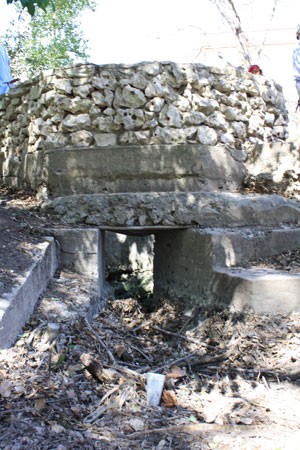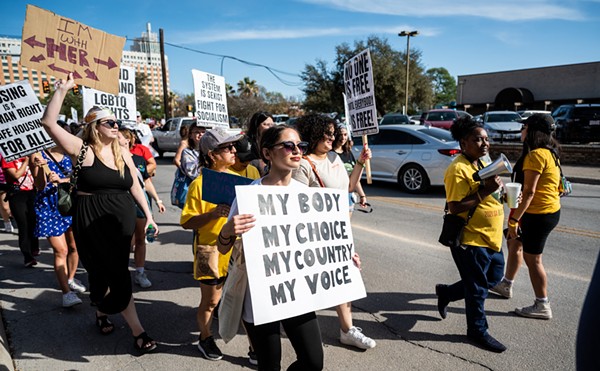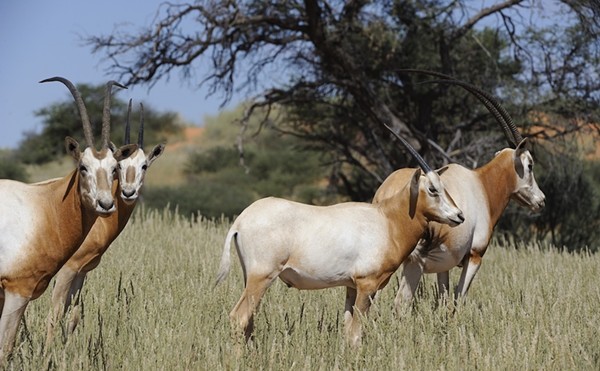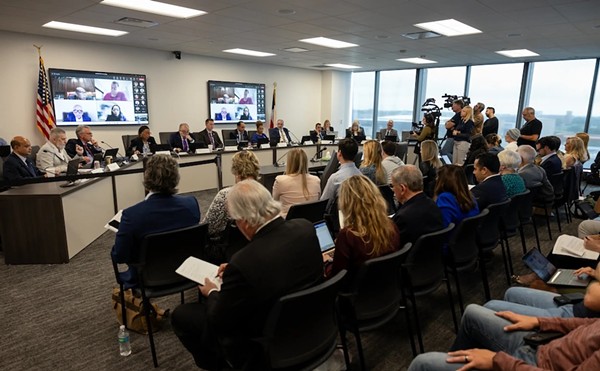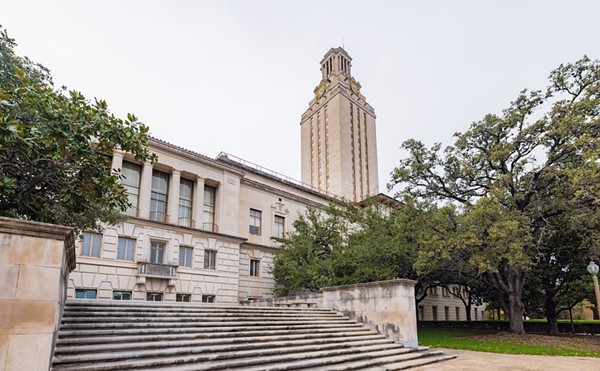Imagine stepping into the San Antonio River.
Close your eyes and imagine wading in, without fear.
There’s no rusted old bed frame lodged in the muck to cut you. No colonies of E. coli or cryptosporidium ready to turn your digestive tract into a razor-tipped cockfight.
Imagine cool sensuality inching up your chest. The sweet smell of rain feeding the stream from fern-gripped limestone springs. Hear the quivering birdsong blink off as your face drops beneath transparent waters.
This is the river as those who first gathered here more than 10,000 years ago experienced it. It is the river — “Yanaguana” to the Coahuiltecan Indians camped here when the gold-fevered Spaniards stumbled by in 1691 — that made San Antonio possible.
In the coming years, local regulators, educators, and volunteers hope to revive Yanaguana from the crippled body of our cruelly neglected and abused San Antonio River. A multi-million-dollar river improvements project is set to extend the River Walk from downtown to the Pearl Brewery by May. Millions more may soon green up the southern Mission Reach section, turning it back into a more natural channel and lining it with tens of thousands of new trees. Serious efforts are being made to improve the water quality of the Upper San Antonio. And volunteers at the river’s headwaters are working to protect and improve the surrounding ecology.
But don’t open your eyes yet. Remember what you have seen. A generous imagination may be the ultimate key to our success.
As construction crews working to extend the River Walk into the museum district north of downtown dart about their grumbling earth movers, a small group of volunteers is gathered two miles north at the Blue Hole, a sacred space for those who adore this river. It is from here, and a handful of nearby springs and their ephemeral creeks, that Yanaguana originally found life.
A small group of volunteers, led by Lacey Halstead, executive director of the Headwaters Coalition, is taking advantage of this period of extreme drought to attack two species of plants that have taken residence in the rocky streambed. It is several hundred yards yet before this hardscrabble headstream is injected with treated septic water and becomes recognizable as a river.
These days, the headwaters flow only irregularly. The river is primarily fed further downstream by the Hippo Well at the San Antonio Zoo and two pumps operated by the San Antonio Water System. Inside the stone circle identifying the spring, two large tree limbs are angled like discarded soda straws. A wash of twigs and bark, mixed with styrofoam, water bottles, and plastic sheets, piles up at the spring’s mouth. The Hole is dry.
As millions of dollars are poured into efforts to bring the River Walk clear to Brackenridge Park, and millions more are sought in federal stimulus funds to turn a channelized stream along the Mission Reach once more into a thing of beauty, the unanswered question remains: When the millions are spent, will a living river flow through San Antonio’s heart?
It is hard to imagine that little more than a year ago, this spring and several others around her were spouting prolific amounts of freshwater. The parking lots and sidewalks of the University of Incarnate Word, itself built atop several of the river’s headwater springs, have been known to buckle and crack as increasingly pressurized groundwater seeks the surface. Halstead saw it firsthand during the supremely wet 2007 after agreeing to lead a midnight effort by the Sisters of Charity to repair the profound ecological damage done to these most sensitive lands.
“On campus, the light posts were spouting water out of their bases,” Halstead said. “It’s incredible, this whole area, it’ll pop up and break holes in the asphalt. I thought people were exaggerating until I first saw it.”
The thrill was short-lived. Just a few months after taking on her new role, the former conservation planner for The Nature Conservancy watched helplessly as the heavens were shut up, to borrow a biblical phrase, and the region entered its driest period since 1885. At the end of 2008, La Niña appeared about to break its hold, but instead the dry streak tightened and is expected to continue for at least several more months, according to the National Weather Service.
It’s the perfect opportunity to attack the non-native plants that choke out those most beneficial to the river. It seems an insane undertaking, pulling weeds to help a river stretching 240 miles all the way to the Gulf of Mexico. It may be crazier to do nothing.
In the beginning, San Antonians were a people who knew the value of water. They knew it by its scarcity, as displayed in the thirsty South Texas landscape. And they knew it by the increasing pressure for clean water as the city’s population increased.
San Antonio experienced its first drinking-water scare when the city was still a good 50 years from tapping the sea of freshwater beneath its feet in the Edwards Aquifer. Many homes still collected rainwater in barrels to supplement what they drew from the river. Texas was in that fragile twilight period, having only recently won its independence from Mexico and still a few years away from being salvaged by the United States.
It was 1840, and San Antonio’s leadership had invited in their Comanche adversaries for a prisoner exchange. Fighting broke out at the Council House and quickly became a slaughter. The eruption of violence eventually laid out a handful of townsfolk, but dozens of Comanche chiefs, warriors, and their families suffered the most. It was just the opportunity Dr. Weidemann, a local surgeon, was waiting for. He waded into the fight on his horse and did his worst. More than 30 Comanches fell in the melee, but Weidemann would need only two: One man and one woman.
After hacking the heads off the bodies, he wheeled a cart back to collect them. He tumbled the corpses into a soap boiler to claim the bones. The less permanent flesh he flushed into the town’s drinking-water canal during the night.
When news of what he had done reached his neighbors in the morning, pandemonium ensued. One local resident told the tale 50 years later to Mary Maverick, who wrote:
“The men talked in loud and excited tones, the women shrieked and cried, they rolled up their eyes in horror, they vomited, and some of them were so frightened that they suffered miscarriage. Many thought they were poisoned and would die.”
Like rivers throughout the world, our San Antonio was a sewer long before fuel additives like MTBE started showing up in lakes and streams. By their very nature, rivers are the perfect disposal system, flushing unwanted or simply misplaced objects of society downstream. Ask any of the 2,400 volunteers who helped pull more than 25 tons of trash out of the river’s Mission Reach and nearby creeks during 2008’s Basura Bash. Ask the Sisters of Charity, a portion of whose land is regularly fed piles of garbage through a series of culverts running beneath U.S. 281.
San Antonio felt the impact of dirty water most acutely during its population explosion of the late 1800s, when sewage ditches routinely mixed with surface drinking-water supplies.
“Commercial effluent was dumped into the ditches or slopped into the river or creeks,” Char Miller writes in Deep in the Heart of San Antonio. “Liquid household wastes and human excreta meant to be captured in cesspools or underground privy vaults invariably leached into the soil and nearby wells.”
Waves of sickness followed.
Responding to the call of a Galveston-based bishop, three young nuns came to San Antonio in 1869 to open what would become the town’s first hospital. About the same time they purchased the headwater lands from George Brackenridge, the banker, newspaper publisher, and leading interest in the town’s private water company punched a well through to the Edwards near Market Street downtown that gushed forth with such velocity and volume that his paper blared: “The freshwater supply of San Antonio is apparently unlimited.”
For economic boosters like Brackenridge, the strike represented infinite potential. It also appeared to signal the end of our reliance on the Yanaguana.
During the 20th century, San Antonio transitioned from complete dependence on the river to a near-complete reliance on the sea of water beneath its feet. The fight up top was about ensuring consistent flow for the mill operators and eliminating the risk of flooding with dams, bridges, and tunnels. In time, the river became little more than a backdrop to the commerce being done on the River Walk.
When Dallas Mavericks owner Mark Cuban famously observed just over a decade ago that the river’s artificial tourist oxbow had become an “ugly-ass, muddy-watered thing,” locals were incensed. It wasn’t what he said so much as how he said it: to a national television audience.
The negative coverage threatened to hit the city — which had grown as adept at selling the Alamo as hawking a raucous stroll to Dick’s Last Resort — in the pocketbook. In fact, Cuban was being generous. He had no way of knowing the still, brown waters were ladled thick with hippopotami poop, or more casually, “zoo doo.” Decades after the Clean Water Act forced the city to stop pumping raw sewage into Mitchell Lake, the San Antonio Zoological Gardens was still enjoying carte-blanche rights of discharge.
It turned out Cuban’s well-publicized critique was echoed by the Texas Commission on Environmental Quality, whose researchers were preparing to list the river as an “impaired” waterway because of high bacteria counts. Testing in the summer of 2005 confirmed that the well water winding through the zoo’s exhibits (including the former hippo pool) and into the river held more than 100 times the bacteria considered acceptable for recreational waters in the state.
“The San Antonio Zoo continually releases a large volume of water from interior water features that have high bacterial counts. The modeling analysis indicated that this point source discharge had a dramatic affect on bacterial counts in the study area under non-runoff conditions,” TCEQ investigators wrote. In mid-2007, the TCEQ adopted new rules for the river in accordance with federal guidelines and the San Antonio River Authority was tasked with creating a plan to get the poop out.
SARA’s response plan built on the state’s finding.
“The San Antonio Zoo, located in Brackenridge Park, has been identified as a major point source contributor of bacteria in the Upper San Antonio River,” that report reads. “According to the water quality model, disinfection (99.9% bacteria removal) of the Zoo’s discharge will bring most of the Upper San Antonio River into compliance with the state criteria, except under periods of prolonged wet weather.”
In other words, the river would be safe enough to swim in if the zoo doo were removed — and if it never rained again.
The Blue Hole is a dual-directional spring. When water levels are high, she freely bestows millions of gallons of pristine Edwards Aquifer water upon San Antonio, water that exceeds the U.S. EPA’s drinking-water criteria in every way.
When it’s dry, she retracts, becoming a receptacle for our gratitude. Violently rushing rainstorms attempt to jam tires, plastic bags, bottles and cans, and a variety of motor fuels and yard chemicals down her throat.
Unfortunately for our urban waterway, it does still rain in San Antonio. And, typically, when it rains, it pours. More than 18 inches in July and August of 2007.
There is not much undeveloped land left surrounding the headwaters of the San Antonio River. Of more than 200 acres the Sisters of Charity purchased from George Brackenridge, a mere 54 acres remain in their original, God-given state. Some of the holdings were sold over time to supplement the nun’s mission, which through the years has included the seeds of the Christus Santa Rosa Health Care System. The city required a small chunk for Olmos Dam. U.S. 281 sliced through the western holdings. Then there is the controversial footprint of the university itself, asphalt and concrete foundations sitting over an unknown number of springs.
Under Halstead, the Headwaters Coalition is developing an ambitious master plan to protect and improve the habitat on these remaining acres and better protect the source of Yanaguana. In the coming years, the group will create an outdoor classroom area, a reflection garden, and a mile of walking trails, half of which will be handicap accessible. Two soccer fields cut into the woodlands in the late ’90s will be turned back over to the trees.
“This is the sister’s commitment for caring for God’s creation,” Halstead said. “But that alone is not enough. They want to inspire a similar earth stewardship in other people. To do that we need to get people out and reconnect them to the land.”
Already, Halstead is leading groups of volunteers along the dry river bed and surrounding forest land to remove invasive plant species, such as chinaberry trees, which stifle the growth of ground-level greenery. By choking out native grasses and shrubs, the invasives help move rainwater, and the pollution it flushes from the city, more easily into the river and underground aquifer.
“This forest really is, though small, an important buffer around Olmos Creek … everything around us is developed,” Halstead tells me. “If this were gone, you’d be getting runoff straight off 281, straight off of the streets, and right into the San Antonio River. We also are looking at what we can do to enhance the water-pollution protection that this site gives. A lot of that gets into improving the vegetation.”
While the zoo presents a relatively easy fix — even if the expected final million-dollar solution, a UV water -treatment facility, is costly — the bulk of pollutants hitting the river are washed off of the surface of roads and parking lots during storms.
“We knew it was more than the zoo. The zoo was the innocent bystander,” Mike Gonzales, environmental sciences manager for SARA, says of the TCEQ’s listing of the river. “They said it’s the zoo. We didn’t believe it.”
Yes, there is another pollution source: All of us. Imagine running the city through a Battlestar-sized car wash to get a sense what a rainstorm means for our river.
About 530 square miles of land drain into the Upper San Antonio. Add to that another 223 square miles draining to the river through the Salado Creek watershed. As the showers wash over city streets, yards, alleys, and parking lots, they scour the impermeable concrete of a range of pollutants, including motor oil, fluff from brake pads, antifreeze, lawn fertilizer, pesticides — anything at all. This “non-point source pollution,” or urban runoff, is the biggest challenge to lakes, streams, ponds, and rivers across the United States, according to the U.S. EPA.
“Because of all the building on the upper watershed, northern San Antonio, you now have floodwater that comes faster and doesn’t have as much ground to be absorbed,” said SARA at-large board member Sally Buchanan.
Despite an anticipated clean finish at the zoo, SARA still needs to cut that stormwater-driven pollution in half to get the river off the state’s impaired waterways list. 2007 surveys of E. Coli levels along the River Walk found they were around 15 times the legal limit.
A bat colony beneath the Houston Street Bridge had to be relocated. Voracious mosquito-eating aside, a colony directly over the river is like a massive hypodermic needle of liquid guano going straight into the river. Great for gardens; hell on rivers with a poop-free mandate. (“We want them in the area. We just don’t want them over the river,” said Gonzales, adding that the agency may try to create replacement bat habitat nearby.)
Car washes and grease traps, sidewalk hosers, and sloppy oil changers must also be addressed. SARA officials have already begun unofficial discussions with the downtown business community about finding ways to change habits to reduce river pollution. Downtown and Upper Loop residents will be encouraged to watch for leaking trash, not leave food out for wildlife, and limit fertilizer use. Expect public hearings and catchy ad campaigns in the near future: “Don’t poop in the Upper Loop,” and the like.
After the city switched over from river water to groundwater for its drinking and septic needs, the impact on the river became obvious quickly. It’s been a long time since she flowed without assistance. Thanks to the numbers of dams across the area, the water in the River Walk behaves more like a pond than a river.
Steve Clouse, chief operations officer at SAWS, said the city was busting holes into the Edwards to enhance river flow as early as the 1930s. Since 2001, SAWS has been relying on treated effluent to move the river. More than four million gallons are pumped into the river behind the Witte Museum at Brackenridge park every day. Another million join the river below the Convention Center downtown.
While the water has been run through a sand filter at the Dos Rios Water Recycling Center and has no measurable bacteria, it’s still not a good idea to drink it. However, the fact that it is high in nitrates is good for many of the commercial customers that buy the water from SAWS for irrigation.
“We don’t remove that because our recycled-water customers … they want that nitrate,” Clouse says.
CPS Energy uses the recycled water to cool the turbines at its coal plants. Toyota signed on, too. Microsoft started pumping the water at their new data center two weeks ago. “There’s a lot of businesses in town that now depend on recycled water,” said Anne Hayden, SAWS appointed spokesperson. “As ironic as it sounds, you almost want folks who come from somewhere else to use the bathroom here, contribute to the recycled-water program, and then drink somewhere else.”
Clouse estimates that roughly 70 percent of the river flow right now comes from SAWS two “recycled water” pumps.
“If we didn’t have that pipe in place right now, the area behind the Witte would go dry,” Clouse said.
SARA’s Mike Gonzales says the zoo discharge has improved slightly but still is roughly equivalent to where it was in 2004. Despite the new hippo exhibit, which filters the water and drains the waste into the septic line, and changes to the way staff clean the exhibits to minimize the flow of feces reaching the San Antonio River, bacteria will likely be a problem until the city installs the ultraviolet treatment, now in the design phase.
Still, the fish don’t seem to mind. Since SAWS replaced a problematic treatment plant with shiny Dos Rios, fish increasingly have been migrating back upstream. Sensitive species like the log perch, bullhead minnow, and freshwater prawn are now regulars as far north as Brackenridge, Gonzales said.
“What we try to do is look at a whole, total-balance aquatic ecosystems,” Gonzales said. “There’s a lot of emphasis put on the bacterial concentrations … To me, the bacteria coming out of the zoo is not really impacting the balanced aquatic ecosystem.”
While improvements along the Mission Reach include measures to improve the ecological health of the river, including a recreated wetlands, the northward River Walk must fit into the already tightly developed land around it.
“There are green areas being put in,” said Steve Schauer, SARA’s spokesperson, “but there are, frankly, a large number of outfalls coming straight in from street level.” Urban runoff will continue to be a serious challenge here.
In the Mission Reach, SARA hopes to return the river to as natural a state as possible, with plenty of bends. “They have learned so much more about the real nature of rivers,” SARA board member Buchanan said. “Rivers meander. If you straighten the river, they will keep trying to meander.”
“That is one thing this River Improvements Project is trying very much to correct, `to` get more meanders back in the river so it behaves like a river. Still keep the flood control, but make it way more beautiful. Give the citizens back their river … Make it look like South Texas.”
All this official attention is taking root at the community level with efforts like the Headwaters Coalition. The cumulative impact of that could finally give us the river we know the San Antonio, at its heart, should be.
There’s an old adage about time and rivers: “You can’t step into the same river twice.” In the case of San Antonio, due to our reliance on recycled water, every time we flush our toilets we essentially create the same river all over again. It’s an unavoidable reality of our intensely engineered river relationship.
Globally, the same principal holds. While freshwater represents only 2.5 percent of the planet’s total water, less than one percent of that is actually drinkable. Those trillions upon trillions of gallons cycle about through the solid, liquid, and gas phases, passing through animals, running down mountains, and bubbling out of freshwater springs. Same water over and again.
For some, it will be difficult to come to terms with the fact that our river now spills from a pipe. But the sooner we grasp the more critical issue, that the water we have today is the same water we will have tomorrow, the sooner each of us will likely come to commiting to do our share of weed-pulling to bring back the Yanaguana together.
Imagine. •
Basura Bash
Last year, 2,400 big-hearted volunteers hauled 25 tons of trash out of the river’s Mission Reach and nearby creeks — and were able to turn around and recycle 3.5 tons of that detritus.
You can show your love for the river (and all the darling little creatures trying to call her home) by pitching in at the 2009 event.
Basura Bash 2009
Saturday, March 7
All day (registration 8-9 am)
Mission County Park
6030 Padre Dr
(210) 858-8520
basurabash.org/event_2009
Hear Lacey Halstead describe the Headwater Coalitions’ plans to protect and improve the habitat around the Blue Hole, birthplace of the San Antonio River.
View the video below of a recent volunteer outing to help eradicate invasive plant species around the headwaters of Blue Hole.
Respect your river
It’s easy to forget you’re a river resident when you never see the river. The majority of those who live in the San Antonio River’s watershed — hundreds of square miles drain into the waterway — rarely even see the San Antonio.
Others may have never thought of the brown, meandering stream wrapping quietly through downtown as an actual river.
Still, as the river improves, more and more folks are becoming interested in doing their part to clean up this vital contributor to the health of South Texas.
Until the San Antonio River Authority publishes its compendium of best practices, tentatively titled The Creek Book, later this year, use these guidelines to prevent further fouling of our Grande Dame.
• Don’t overfertilize your lawn.
• Plant local, drought tolerant grasses, bushes, and trees.
• Pick up after your pet.
• Take care when changing your oil and filters to present spills.
• Don’t leave trash bags on the ground.
• Do not leave food out for wildlife.
• Don’t harbor invasive plants (texnat.tamu.edu/cmplants/toxic).
• Consider using permeable building material, such as gravel or bricks, for outdoor paths, driveways, and patios.
Slideshow of river images by Greg Harman, from the Blue Hole to the Dos Rios Water Recycling Center.

